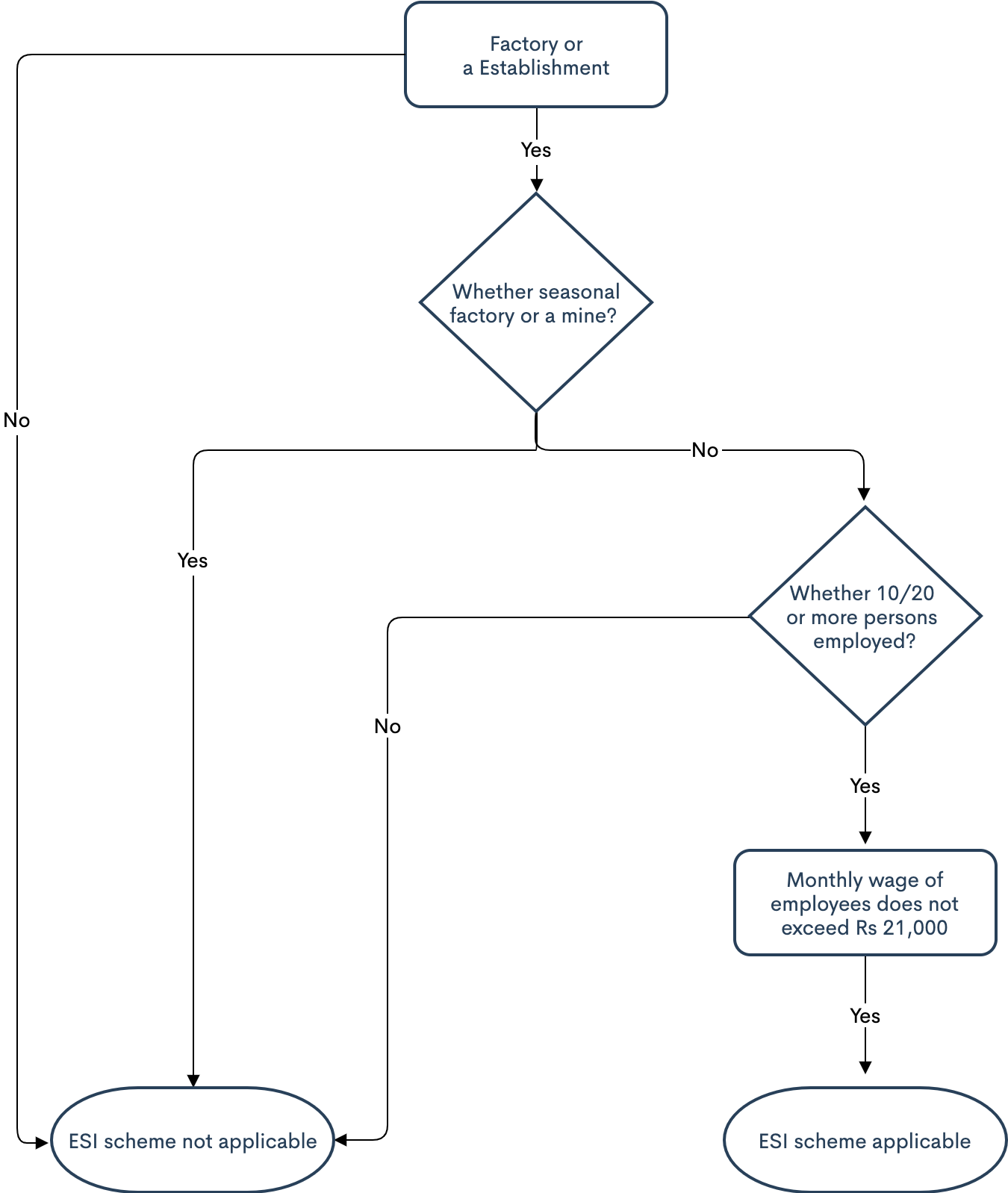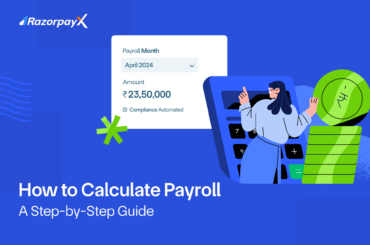Table of Contents
ESI Full Form
ESI stands for Employees’ State Insurance, and it is a health insurance plan offered by the Indian government to Indian employees. The scheme is regulated by the Employees State Insurance Corporation (ESIC).
Under this scheme, employers and workers are required to contribute to a social insurance fund, which is to be utilized to grant benefits to them. Employees of any eligible organization are protected against financial distress arising out of sickness, disablement, and death due to employment injury.
Who is covered under the ESI scheme?
According to the ESI Act 1948, the scheme applies to all factories and other establishments where the employee strength is 10 or more. The scheme covers both organized and unorganized sectors.
The same rules apply to a non-seasonal factory where the employee count is 10 or more. Furthermore, the applicability of this scheme has been extended to shops, hotels, restaurants, educational institutions, newspaper establishments, cinemas, and private medical institutions since 2001.
However, the employee strength required for ESI registration for factories is 10 for PAN India. For establishments, this threshold is 10 or 20 depending on the state.
| Minimum number of employees required for registration of establishment | ||
| Sl. no | State | Minimum employees to be registered |
| 1 | Himachal Pradesh | 20 |
| 2 | Jammu & Kashmir | 20 |
| 3 | Jharkhand | 10 |
| 4 | Kerala | 10 |
| 5 | Madhya Pradesh | 20 |
| 6 | Maharashtra | 20 |
| 7 | Manipur | 20 |
| 8 | Meghalaya | 20 |
| 9 | Mizoram | 20 |
| 10 | Nagaland | 20 |
| 11 | Orissa | 10 |
| 12 | Pondicherry | 10 |
| 13 | Punjab | 10 |
| 14 | Rajasthan | 10 |
| 15 | Sikkim | 20 |
| 16 | Tamil Nadu | 20 |
| 17 | Tripura | 10 |
| 18 | Uttar Pradesh | 20 |
| 19 | Delhi | 10 |
| 20 | Karnataka | 10 |
| 21 | West Bengal | 10 |
| 22 | Andhra Pradesh | 10 |
| 23 | Arunachal Pradesh | 20 |
| 24 | Assam | 20 |
| 25 | Bihar | 10 |
| 26 | Chhattisgarh | 10 |
| 27 | Goa | 20 |
| 28 | Gujarat | 10 |
| 29 | Haryana | 10 |
| 30 | Uttarakhand | 10 |
| 31 | Chandigarh | 20 |
| 32 | Daman and Diu | 20 |
| 33 | Dadra and Nagar Haveli | 20 |
| 34 | Andaman and Nicobar | 20 |
| 35 | Lakshadweep | 20 |
| 36 | Outside India | 20 |
Eligibility for ESI Registration in India
Employees with monthly wages of INR 21,000 or less are covered under the ESI Act. This wage limit of INR 21,000 was increased from INR 15,000 in December 2016.
 Benefits of ESI
Benefits of ESI
The ESI scheme provides the following benefits to insured employees.
- Full medical care during the period of their incapacity and their restoration to health and working capacity
- Financial aid to compensate for the loss of wages during the period of employee absenteeism from work due to sickness, injury due to employment, pregnancy, and hospitalization in any ESI hospital
- Sickness benefits in the event of any medically certified illness for a maximum of 91 days in a year
- Paid leave to pregnant women insured under this scheme
- In the event of death of an employee, 90% of their wages will be paid to their dependents for the rest of their lives
- Employee funeral expenses covered up to Rs 15,000
- In case of temporary disablement, 90% of the employee’s wages will be paid for the duration of the disability
- In case of permanent disablement, 90% of the wages will be paid depending on medical certification
- Medical insurance coverage to employee’s family members.
The income limit for availing medical benefits under the ESI scheme by the dependent parents of an insured person has been enhanced to INR 9,000 per month from INR 5,000 in February 2019.
Procedure for ESI Registration
Any employer falling into the eligible category can get its factory or establishment registered under ESI through the ESIC website. The process is very simple – here are the steps to get registered on the ESIC website as an employer.
Step 1: Login to the ESIC Portal
The first step is to get registered as an employee on the ESIC Website. If you’re not already registered, create an account with the ESIC on this link. You can also find this link on the main ESIC homepage.
Once you reach the login page, click on the link that says Common Registration Link For ESIC / EPFO. 
This will take you to the Shram Suvidha online registration and licensing facility. Find “Registration” in the top navigation bar and hover to find “Registration under EPF-ESI”.

Step 2: Create an Account on Shram Suvidha Portal
Once you click on “Registration Under EPF-ESI”, you should be redirected to the Shram Suvidha login page. On this page, you will find a link to create an account if you don’t already have one.
Click on this link to be redirected to the Sign Up With Shram Suvidha Portal. Once on this portal, you will need to provide the following details:
- Name
- Mobile number
Step 3: Email Verification
For the next step, you will need to go to your email inbox and click on the verification link sent to you with the subject line ‘Shram Suvidha Portal | Registration Confirmation’. Upon clicking the link, you should be redirected to the USSP Portal, where you can activate your registration.
You will need to enter one more OTP after which you can set up your unique User ID and Password. Make sure to follow the requirements for the password and user ID listed on the site.
Once verified, click submit to be once again redirected to the login page, where you will need to login to access your dashboard.
Step 4: Register as an Employer on the Dashboard
Once on the dashboard, look for “Register” on the top navigation similar to step one.
Click on “Registration Under EPF-ESI”, and you’ll be redirected to the “Common Registration form for ESIC & EPFO” portal, where you’ll be required to enter details like your establishment name, workplace address, factory license details and more.
Note: ESI registration for new public and private limited companies can get their registration numbers for EPF and ESI on www.mca.qov.in.
Step 5: Registration Payment and Letter
After you submit the ESI registration form, you will need to make an initial payment of six months advance contribution. You can make the payment online via a number of payment gateways. Once the payment is done, you will receive a registration letter which will be sent to you on email.
This registration letter contains a 17-digit registration number assigned by the ESIC department which serves as proof of registration.
ESI Contribution Rates and Calculation
ESI contributions are calculated on the wages earned by the employee. Currently, employees contribute 0.75% of their wages, while the employer’s contribution is 3.25%. These rates are subject to revision from time to time.
The total ESI contribution is the total of the employee’s and employer’s contribution. Let’s use an example to understand further.
Sarah earns a monthly gross salary of ₹25,000. Let’s calculate her ESI contribution:
- Employee Contribution: ₹25,000 x 0.75% = ₹187.50
- Employer Contribution: ₹25,000 x 3.25% = ₹812.50
Total ESI Contribution: ₹187.50 (Employee) + ₹812.50 (Employer) = ₹1,000
Therefore, in this example, the total ESI contribution for Sarah would be ₹1,000 per month, with ₹187.50 deducted from her salary and ₹812.50 contributed by her employer.
What are the due dates for the ESI payment and return filing?
An employer should pay their contribution and the employees’ contribution on a monthly basis to the ESIC. The due date for paying ESI contributions is the 15th of the following month.
Further, an employer needs to file an ESI return on a half-yearly basis. Here are the due dates for filing half-yearly ESI returns:
| Period of return | Due date of filing returns |
| April to September | 11th November |
| October to March | 11th May |
However, these due dates can be extended or changed through an official notification by the ESIC department.
It can be difficult for employers to keep up with all these dues dates and pay the dues on time. To streamline this entire process, we built RazorpayX Payroll.
RazorpayX Payroll processes payroll using a direct deposit model as long as a user maintains the balance. You can think of it as a wallet from which payroll expenses are automatically paid.
All the statutory payments like ESI, PF, TDS, and PT are automatically deducted and paid within their due dates. The product also deals with their periodical return filings.
What is the penalty for non-payment or late payment of contributions?
Simple interest of 12% per annum for each day of delay in payment will apply to every employer who fails to pay the ESI contributions on time.
Also, non-payments, delayed or false payments under the ESI Act may attract imprisonment for a period extending up to 2 years and a fine up to INR 5,000.
Further, the income tax act also disallows ESI contributions deposited after the due date. The employers shall not get the deduction benefit of such contributions and will end up paying income on it.
Documents Required for ESI Registration
Here is a list of documents needed for ESI registration:
- Business PAN card
- Business address proof
- Registration certificate in the case of Pvt Ltd companies
- Detailed list of employees and income earned
- List of associates, directors and shareholders of the company
- Business bank statements and proof of operations
The conclusion
If you want to spend your valuable time managing core business operations and not worrying about the statutory dues, experience payroll compliance automation like never before try RazorpayX Payroll now!
It provides you with one-click, seamless, and end-to-end automated payroll processing experience. Also, you can keep track of leaves and attendance, make vendor payments while being compliant with the latest regulations.
Frequently Asked Questions
What is the full-form of ESI?
ESI stands for Employee State Insurance
How is the total salary calculated?
ESI will be calculated on the gross salary (basic and loss of pay dependent allowances) up to ₹21,000. If Gross is above ₹21,000, then ESI remains constant.
Who is eligible for ESI?
The ESI scheme is applicable to all factories and other establishments with 10 or more people employed in such establishments and the beneficiaries' monthly wages do not exceed INR 21,000.
What are the PF & ESI rules?
From your basic salary, PF deduction would be 12% as employee contribution and 12% for company contribution. ESIC deduction would be 0.75% for employee contribution and 3.25% for company contribution respectively.
What are the benefits of ESI?
ESI provides a monthly cash allowance for a duration of 24 months in case of involuntary loss of employment, ESIC provides monthly payment apportioned among dependants in case of death due to employment injury, ESIC provides continuous monthly payment till injury lasts for the temporary disabled and for life for the permanent disabled , and ESIC provides 70% of average daily wages in cash during medical leave instances
Should employers register under the ESI scheme?
Yes, employees should register themselves on the ESIC Portal.
What is the interest charged for late payment of ESI contribution?
Employers who fail to pay the contribution within the limit specified in the rules are liable to pay simple interest at the rate of 12% per annum in respect of each day of delay in the payment of contribution.
What is an ESI code number?
Your ESID Number, or Electric Service Identifier, is a number that is unique to your property address. It is a 17 digit identification number allotted by the Regional Office.









